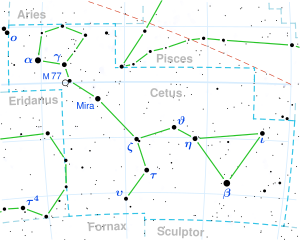고래자리 49
49 Ceti| 관측 데이터 신기루 J2000 이쿼녹스 J2000 | |
|---|---|
| 별자리 | 세토스 |
| 우측 상승 | 01h 34m 37.77883s[1] |
| 탈위임 | −15° 40′ 34.8981″[1] |
| 겉보기 크기 (V) | 5.607[2] |
| 특성. | |
| 스펙트럼형 | A1V[3] |
| U-B색지수 | +0.05[4] |
| B-V색지수 | +0.07[4] |
| 아스트로메트리 | |
| 방사 속도 (Rv) | +10.30±0.7km[5]/s |
| 고유 운동 (μ) | RA: 94.168mas[1]/yr Dec.: -3.성탄절[1]/연령 |
| 시차 (π) | 17.5234 ± 0.1001[1] 마스 |
| 거리 | 186 ± 1 리 (57.1 ± 0.3 pc) |
| 세부사항[6] | |
| 미사 | 2.02 M☉ |
| 루미도 | 19.12 L☉ |
| 표면 중력 (log g) | 4.30[7] cgs |
| 온도 | 8790 K |
| 금속성 [Fe/H] | 0.10 덱스 |
| 회전 속도 (v sin i) | 196km/s |
| 나이 | 40[8] 마이어 |
| 기타 지정 | |
| 데이터베이스 참조 | |
| 심바드 | 자료 |
49 세티는 적도 별자리의 단일 별이다[9].육안으로는 겉으로 보이는 시각적 크기가 5.607인 희미한 흰색 후두 별로 보인다.[2]이 별은 시차를 기준으로 태양계로부터 186광년(57파섹) 떨어진 곳에 위치해 있으며,[1] 방사상 속도 +10km/s로 더 멀리 떠내려가고 있다.[5] 49 세티는 4천만년 된 아르구스 협회의 일원으로 확인되었다.[8]
이것은 A1V의 별 분류를 가진 젊은 A형 주계열성이다.[3]약 4000만년[8] 된 것으로 회전율이 높은 편이며, 196km/s의 예상 회전속도를 보여준다.[6]그 별은 태양의 두 배의 질량을 가지고 있다.[6]그것은 광권으로부터 태양 광도의 19배인 8,790 K의 유효온도로 방사하고 있다.[6]
49 Ceti는 항성을 도는 파편 원반의 특징인 적외선 과다를 나타낸다.특이하게도 이 원반은 일산화탄소(CO) 가스의 흔적이 있는 등 가스가 풍부한 것으로 보인다.이 일산화탄소 가스는 태양계의 카이퍼 벨트와 유사하게 원반 내의 별 주위를 도는 혜성에서 나온 것일 수 있다.[8]
참조
- ^ a b c d e f Brown, A. G. A.; et al. (Gaia collaboration) (August 2018). "Gaia Data Release 2: Summary of the contents and survey properties". Astronomy & Astrophysics. 616. A1. arXiv:1804.09365. Bibcode:2018A&A...616A...1G. doi:10.1051/0004-6361/201833051.이 소스에 대한 가이아 DR2 기록 VizieR.
- ^ a b Høg, E.; et al. (2000). "The Tycho-2 catalogue of the 2.5 million brightest stars". Astronomy and Astrophysics. 355: L27–L30. Bibcode:2000A&A...355L..27H.
- ^ a b Roberge, A.; Kamp, I.; Montesinos, B.; Dent, W. R. F.; Meeus, G.; Donaldson, J. K.; Olofsson, J.; Moór, A.; Augereau, J.-C.; Howard, C.; Eiroa, C.; Thi, W.-F.; Ardila, D. R.; Sandell, G.; Woitk e, P. (2013). "Herschel Observations of Gas and Dust in the Unusual 49 Ceti Debris Disk". The Astrophysical Journal. 771 (1): 69. arXiv:1305.2894. Bibcode:2013ApJ...771...69R. doi:10.1088/0004-637X/771/1/69. S2CID 1630036.
- ^ a b Rybka, E. (1969). "The corrected magnitudes and colours of 278 stars near S.A. 1-139 in the UBV system". Acta Astronomica. 19: 229. Bibcode:1969AcA....19..229R.
- ^ a b Gontcharov, G. A. (2006). "Pulkovo Compilation of Radial Velocities for 35 495 Hipparcos stars in a common system". Astronomy Letters. 32 (11): 759–771. arXiv:1606.08053. Bibcode:2006AstL...32..759G. doi:10.1134/S1063773706110065. S2CID 119231169.
- ^ a b c d Zorec, J.; Royer, F. (2012). "Rotational velocities of A-type stars. IV. Evolution of rotational velocities". Astronomy & Astrophysics. 537: A120. arXiv:1201.2052. Bibcode:2012A&A...537A.120Z. doi:10.1051/0004-6361/201117691. S2CID 55586789.
- ^ Pawellek, Nicole; et al. (September 2014), "Disk Radii and Grain Sizes in Herschel-resolved Debris Disks", The Astrophysical Journal, 792 (1): 19, arXiv:1407.4579, Bibcode:2014ApJ...792...65P, doi:10.1088/0004-637X/792/1/65, S2CID 119282523, 65.
- ^ a b c d Zuckerman, B.; Song, Inseok (2012). "A 40 Myr Old Gaseous Circumstellar Disk at 49 Ceti: Massive CO-Rich Comet Clouds at Young A-Type Stars". The Astrophysical Journal. 758 (2): 77. arXiv:1207.1747. Bibcode:2012ApJ...758...77Z. doi:10.1088/0004-637X/758/2/77. S2CID 119198485.
- ^ Eggleton, P. P.; Tokovinin, A. A. (September 2008). "A catalogue of multiplicity among bright stellar systems". Monthly Notices of the Royal Astronomical Society. 389 (2): 869–879. arXiv:0806.2878. Bibcode:2008MNRAS.389..869E. doi:10.1111/j.1365-2966.2008.13596.x. S2CID 14878976.



